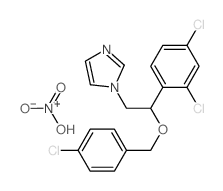Econazole nitrate

Econazole nitrate structure
|
Common Name | Econazole nitrate | ||
|---|---|---|---|---|
| CAS Number | 68797-31-9 | Molecular Weight | 444.69600 | |
| Density | N/A | Boiling Point | N/A | |
| Molecular Formula | C18H16Cl3N3O4 | Melting Point | N/A | |
| MSDS | N/A | Flash Point | N/A | |
|
The use of ammonium hydroxide as an additive in supercritical fluid chromatography for achiral and chiral separations and purifications of small, basic medicinal molecules.
J. Chromatogr. A. 1218(43) , 7886-94, (2011) This study describes using 0.1% of a 28-30% ammonium hydroxide solution as an additive to alcohol modifiers in SFC to improve chromatographic peak shapes for basic molecules. Ammonium hydroxide's high volatility leaves no residual additive in the purified sam... |
|
|
Effect of methoxychlor on Ca(2+) movement and viability in MDCK renal tubular cells.
Basic Clin Pharmacol Toxicol. 111(4) , 224-31, (2012) The effect of the insecticide methoxychlor on the physiology of renal tubular cells is unknown. This study aimed to explore the effect of methoxychlor on cytosolic Ca(2+) concentrations ([Ca(2+) ](i) ) in MDCK renal tubular cells using the Ca(2+) -sensitive f... |
|
|
Effect of diindolylmethane on Ca(2+) movement and viability in HA59T human hepatoma cells.
Arch. Toxicol. 85(10) , 1257-66, (2011) The effect of diindolylmethane, a natural compound derived from indole-3-carbinol in cruciferous vegetables, on cytosolic Ca(2+) concentrations ([Ca(2+)](i)) and viability in HA59T human hepatoma cells is unclear. This study explored whether diindolylmethane ... |
|
|
Effect of phenethyl isothiocyanate on Ca2+ movement and viability in MDCK canine renal tubular cells.
Hum. Exp. Toxicol. 31(12) , 1251-61, (2012) The effect of the natural compound phenethyl isothiocyanate (PEITC) on cytosolic Ca(2+) concentrations ([Ca(2+)](i)) and viability in MDCK renal cells is unknown. This study explored whether PEITC changed [Ca(2+)](i) in MDCK cells using the Ca(2+)-sensitive f... |
|
|
Periocular rash.
JAMA 306(11) , 1263-4, (2011)
|
|
|
Design and synthesis of 1H-1,2,3-triazoles derived from econazole as antitubercular agents.
Bioorg. Med. Chem. Lett. 22(22) , 6844-7, (2012) Econazole has been known to be active against Mycobacterium tuberculosis. We have designed and synthesized 1H-1,2,3-triazoles derived from econazole as antitubercular agents. The majority of triazole derivatives have been prepared by microwave-assisted click ... |
|
|
Oleic acid inhibits store-operated calcium entry in human colorectal adenocarcinoma cells.
Eur. J. Nutr. 51(6) , 677-84, (2012) Much evidence indicates the association between dietary fat and colorectal cancer risk. However, most of the studies focus on polyunsaturated fatty acids, and little is known about the role of monounsaturated ones and their precise mechanism of action. Being ... |
|
|
In-situ gel formulations of econazole nitrate: preparation and in-vitro and in-vivo evaluation.
J. Pharm. Pharmacol. 63(10) , 1274-82, (2011) This study describes the in-situ gelling of econazole nitrate containing thermosensitive polymers composed of poloxamer 407 and 188 as a novel treatment platform for vaginal candidiasis.Aqueous thermosensitive formulations containing 1% of econazole nitrate a... |
|
|
Common features of periocular tinea.
Arch. Ophthal. 129(3) , 306-9, (2011) To present the common features of periocular tinea to aid physicians in future diagnosis and therapy of this condition, because superficial fungal infections on the face are often misdiagnosed owing to the diverse morphologies that they manifest. This is espe... |
|
|
An enlarged, adaptable active site in CYP164 family P450 enzymes, the sole P450 in Mycobacterium leprae.
Antimicrob. Agents Chemother. 56(1) , 391-402, (2012) CYP164 family P450 enzymes are found in only a subset of mycobacteria and include CYP164A1, which is the sole P450 found in Mycobacterium leprae, the causative agent of leprosy. This has previously led to interest in this enzyme as a potential drug target. He... |